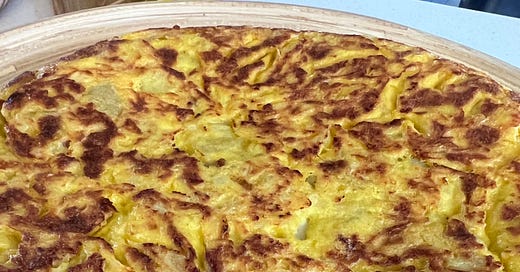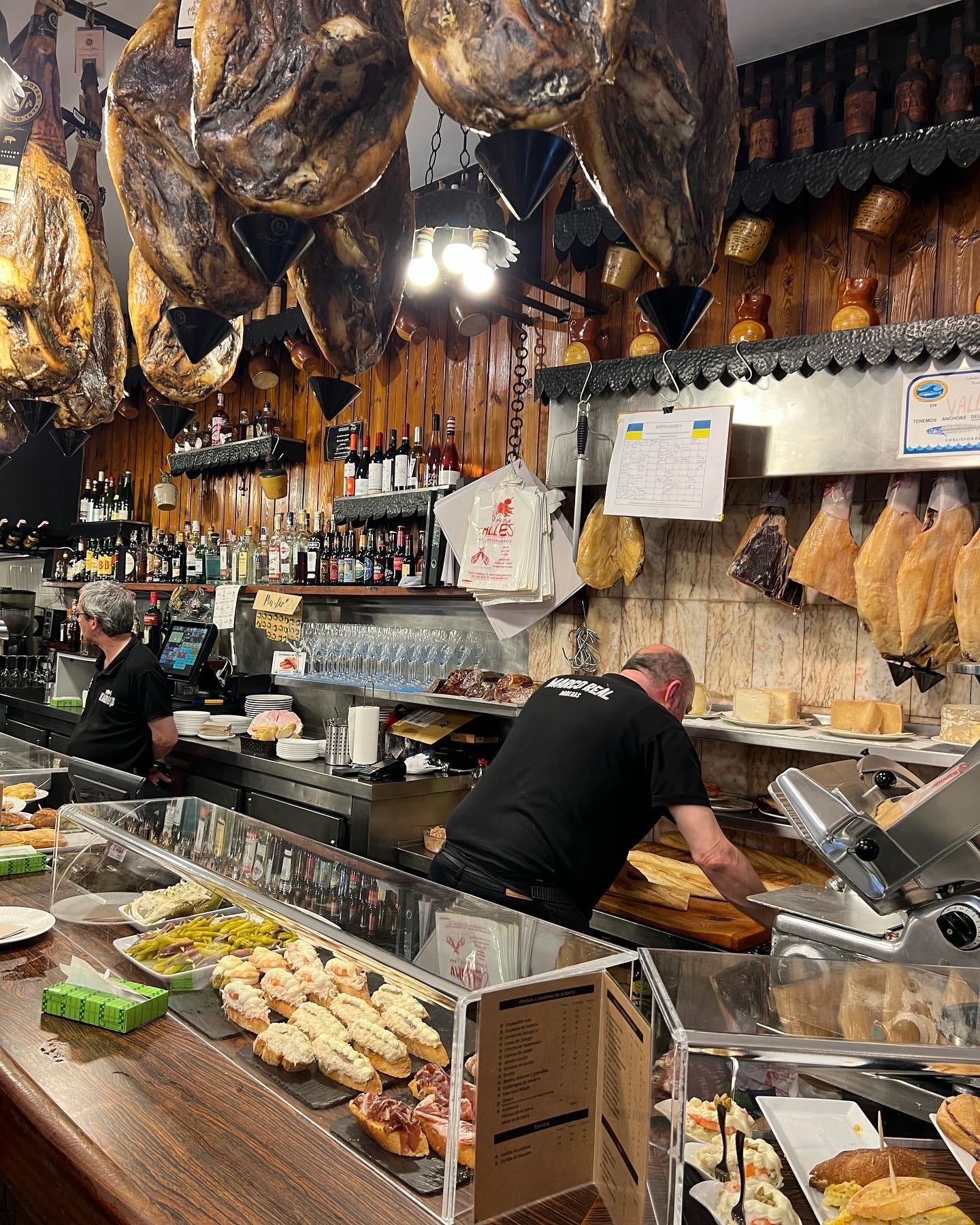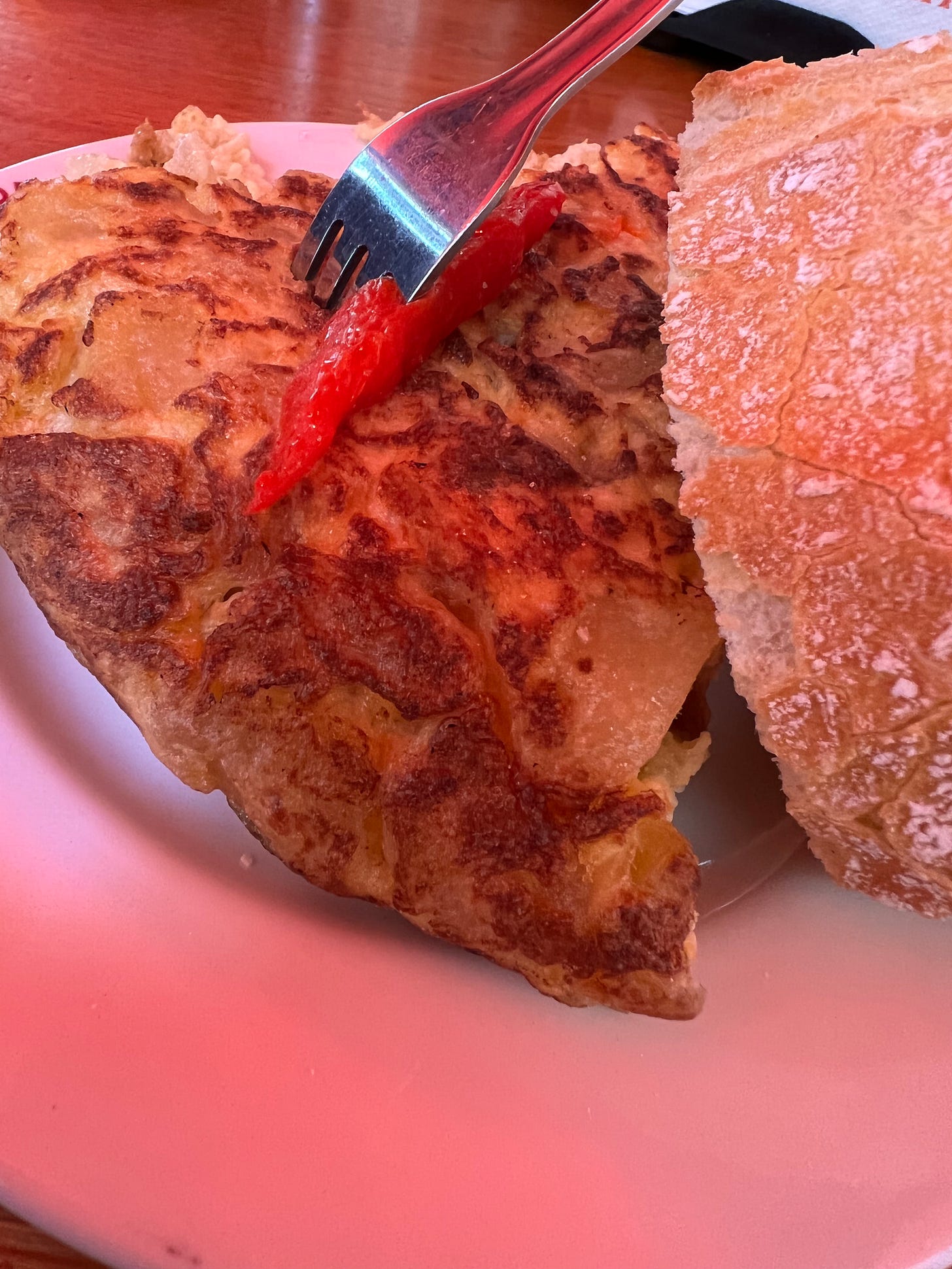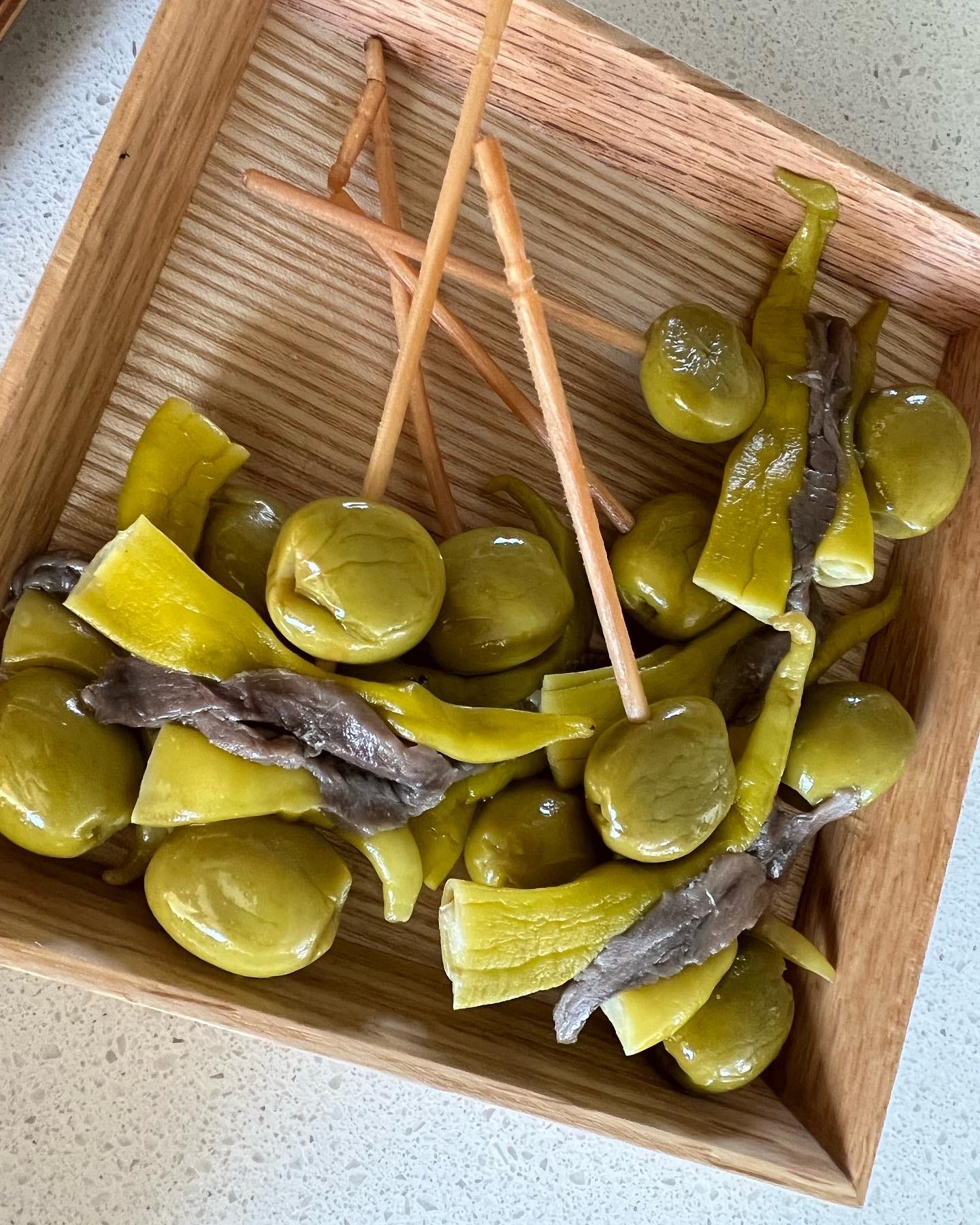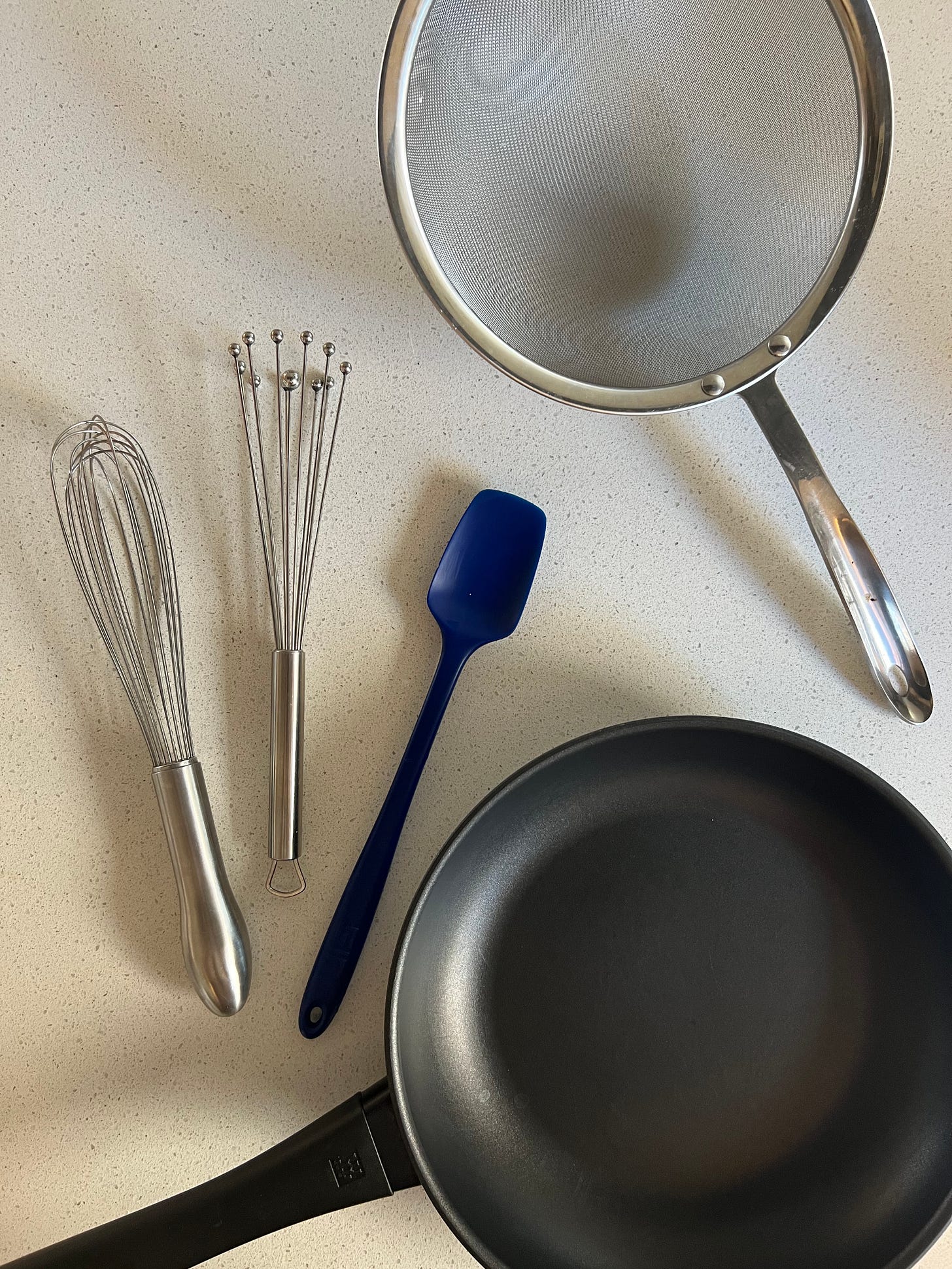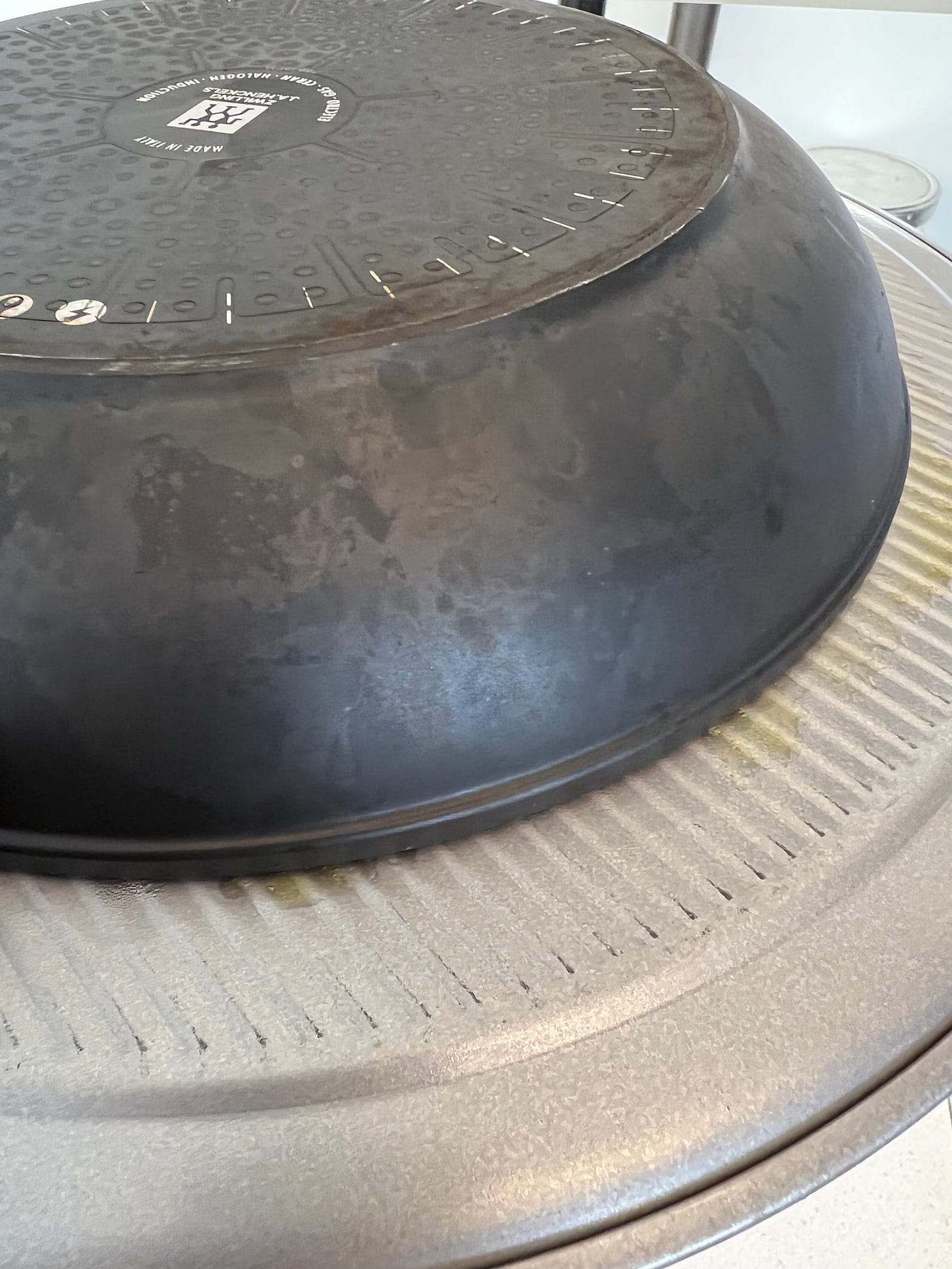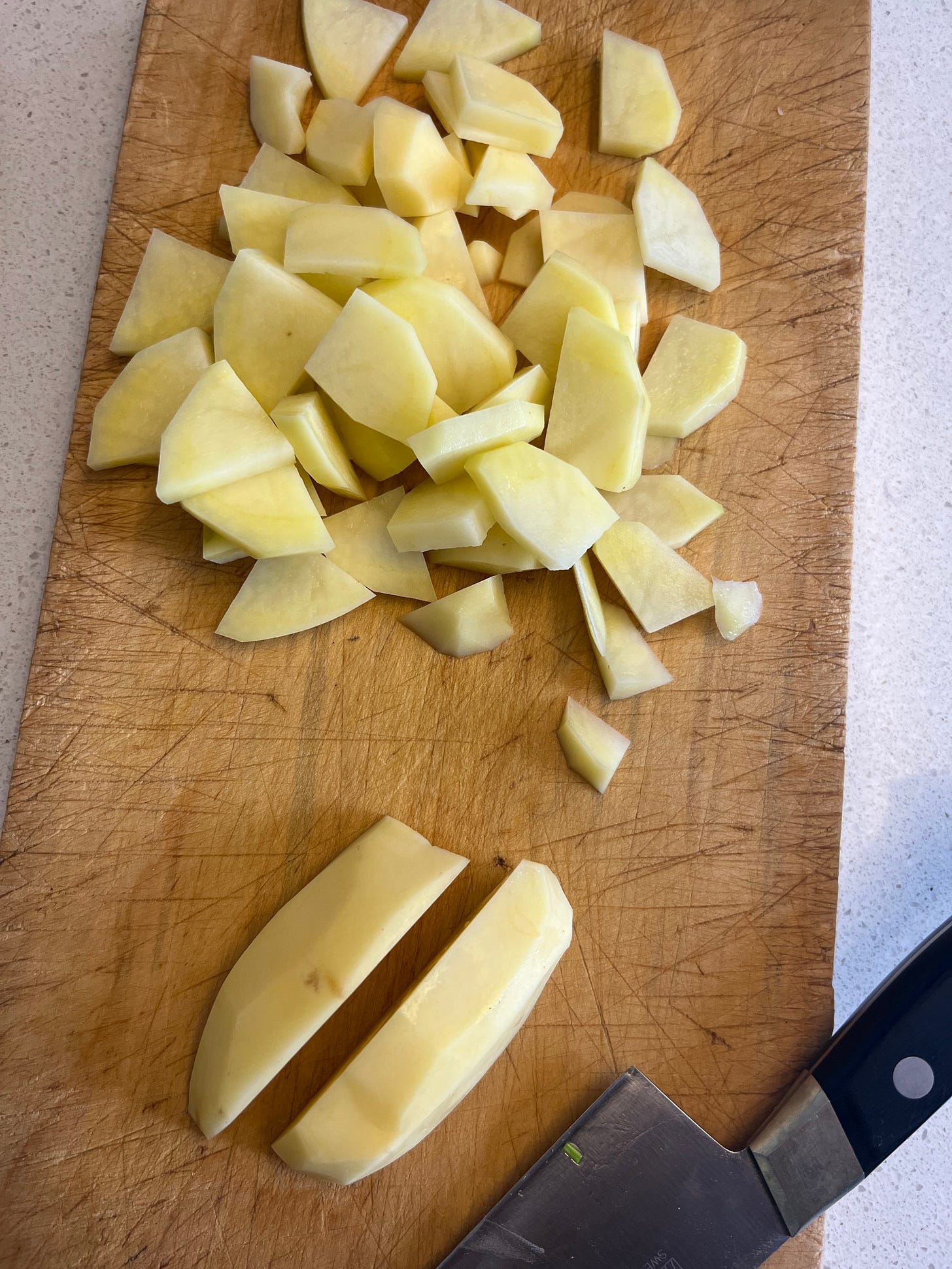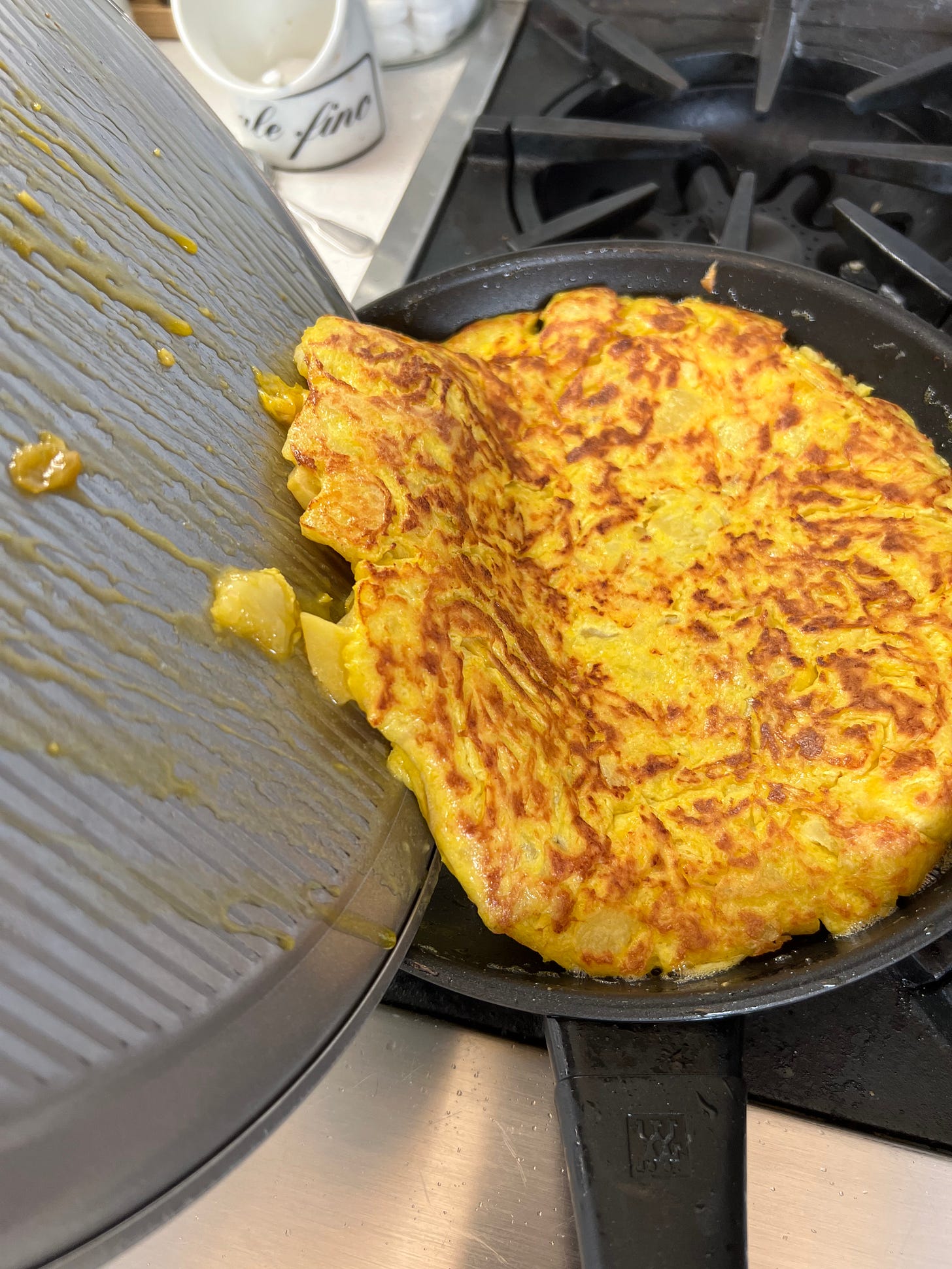In Spain, Tortillas Are Made with Eggs
Recipe for the Rightfully Ubiquitous Spanish Potato Omelette, Simple Food Requires Quality Ingredients, and Overcoming Your Fear of Flipping
Hi, all! Issue #51 is in hand. I hope you enjoy a little of the flavor of my recent trip to Spanish Basque Country. Paid subscribers should look for a pocket notebook to eating in Bilbao and San Sebastian coming to your inbox in the next couple of weeks. In the meantime, I hope you enjoy this issue and this recipe. Thank you for your continued support. —Mitchell
When I was thinking about the subject for this week’s newsletter, I wanted it to be something that allowed me to share my enthusiasm for the indescribably delicious food I just enjoyed this weekend in Spain’s Basque Country. The combination of tradition, pride, quality ingredients, creativity, and hospitality that you find in that part of the world makes it truly one of the world’s great culinary destinations. But I also wanted it to be something you would be able to replicate at home with ingredients you can easily find. So much of the food in the cafes, pintxo bars, cazuelitas ,and restaurantes is simple, but it relies on the unique qualities of Spanish ingredients and produce to make it special. Dishes can be difficult to replicate without complicated sourcing—not that that has ever stopped me before.
Luckily for those of us who live far away from Spain, a significant component of Spanish cuisine takes the form of conservas, or preserved foods, specialty items of the highest quality, priced accordingly, that come in tins and jars. These include all kinds of fish and seafood, vegetables, beans, and more. There are also unique hams and cheeses, which travel well, too. (Note, despite the enticing displays of jamón ibérico in the airport, it is technically not legal to bring any kind of meat, including ham, into the U.S.) . An excellent stateside source for Spanish ingredients, including conservas, is Despaña, an importer with a beautiful shop and café in SoHo and a robust website from which you can order many delicious things to be shipped.
But what to cook to preserve the flavor and feeling of my trip? I decided on the ubiquitous and delicious tortilla de patatas (aka tortilla española), a “potato omelet” you find in pintxo bars and cafés all over Basque Country and throughout Spain. Spanish tortillas have nothing to do with Mexican corn or flour tortillas, except that they are round. They are more similar to Italian frittatas, but tortillas are more pervasive in Spain than frittatas are in Italy. Certain pintxo bars in San Sebastian are known to “release” fresh tortillas at specific times of the day, and people line up to get them hot and creamy out of the pan. To be honest, there is so much olive oil and salt in a good tortilla de patatas that I think they are still very good after they have sat out at couple of hours at room temperature. That’s why they are perfect at a tapas bar, but it all makes them a good addition to an hors d’oeuvre spread at a dinner party or an entrée on a big brunch buffet.
My travel companions this weekend and I took special note of the potatoes we ate everywhere in Spain, as French fries, roasted or boiled, in the form of patatas bravas, and in the famous tortilla. They were particularly flavorful and had a creamy texture, which no doubt contributes to the deliciousness of the tortillas you find there. (See comment above about the importance of quality ingredients in simple preparations.) When I make a tortilla de patatas in New York, my preference is for German Butterball potatoes which have the creamy texture of European potatoes. I buy them at the Union Square Greenmarket. If you can’t find them or another creamy potato, use small Yukon Golds. Don’t use Russets or any other starchy potato that will have a mealy texture when fried or waxy Red Bliss potatoes that remain firm when cooked.
People think the quality of your eggs is important for the finished tortilla, or any egg dish, for that matter. Washington Post nutrition and food writer, Tamar Haspel, whose charming new memoir To Boldly Grow follows her and her husband’s exploits in growing, hunting, fishing, and foraging for their own food, which includes raising chickens, insists that no one can tell the difference between the taste of eggs of one kind or source or another. (See article.) You can believe this, and I have no reason to doubt it, or you can only use farm fresh eggs, as I do, because they make you feel better. I like to support our local farmers, regardless of whether or not their eggs taste better. I think the richness of the yolks is really what you should be concerned about to make a good tortilla, so I add a couple of extra ones to increase the creaminess of the finished dish.
You will balk at the amount of olive oil called for in this recipe. Don’t worry, you won’t consume it all. At least not in this dish. But the oil is necessary to properly fry the potatoes so they stay soft and creamy. Most of it will be drained off once the potatoes are cooked. You can save it for another use. I recommend using an inexpensive extra-virgin olive oil for the task because heating olive oil has been proven to diminish the distinctive flavor qualities of finer oils. Despite what you have heard about smoke points of oils, even sometimes from famous American chefs, frying in extra-virgin olive oil is very common in Spain and Italy and in every olive oil culture.
The basic tortilla is simply potatoes and eggs, but I like mine with some onion, which is popular. You will also see them with cheese, ham, ham and cheese, tuna, and other frivolities therein. But there is no need to gild the lily here. (You may “gilda” the lily, by adding the national pinxto of olive, hot pepper and anchovy on a skewer known as La Gilda, but that’s something else, entirely.) A tortilla is delicious on its own. It is also good on bread. It can be served as breakfast, lunch, dinner, appetizer, entrée, or snack. It is perfect plain and delicious with a sauce, such as a romesco or salsa verde.
What You will Need
Although the recipe for tortilla is simple, a few key pieces of equipment will make the cooking easy. You’ll need a good nonstick pan. Though you will see folks reference the effectiveness of a well-seasoned, carbon-steel pan, I think that when it comes to eggs, it best to leave such a moody device to the professionals. I have a new nonstick pan that is amazing and it’s one of the reasons I’m making tortillas again these days. A good silicon spatula, not too wide and not too hard, comes in very handy. I love my Gir spoonula. Also, though not essential, one of those funny whisks with straight whips that end in little balls is ideal for mixing the eggs again once the potates and onions have been added. You’ll need a strainer and a few bowls, too. Finally, a flat lid, rimless plate, pizza pan, or an inverted sheet pan is essential for flipping the tortilla. See below.
Overcome Your Fear of Flipping
Probably the only challenging thing about making a tortilla is flipping it. But here’s the thing. Because the tortilla actually gets better the more times you flip it, you don’t really have to worry about messing it up. The first flip, before the top crust forms to encase the soft egg center is the only challenging one. And if you mess it up, provided it doesn’t end up on the floor, you just pack it back in the pan and let it cook some more before you flip it again. All you need is an assist from a flipping device, for which you can use a large rimless platter or plate, a flat lid of a large pan (I like a lid because you can hold onto the handle), an inverted sheet pan, or even a rimless or inverted pizza pan, and you can’t go wrong.
When the first side is ready, you put the flipping device on top of the pan. Using an oven mitt or a good wad of kitchen towel, press the device against the pan. Standing over a sink (the first couple of times, anyway), flip the whole thing so the pan is on top and the omelet drops onto the flipping device. You need the mitt or towel because the lid will get very hot very quickly, especially if it is metal. If anything sticks to the pan, scrape it free and patch it onto the omelet. Once flipped, you simply slide the tortilla back into the pan. Don’t worry if it’s messy. Use your spatula to tuck in the sides of the omelet back. With each subsequent flip the tortilla will get more compact and its shape will hold. It’s like magic, really.
RECIPE: Tortilla de Patatas (with Onions)
Makes one 10-inch tortilla, enough for 6 to 14 people, depending on what else you are serving with it.
8 large eggs
2 egg yolks
Sea salt
1 ½ pounds potatoes (about 5 medium), more on the creamy side than the starchy side, such as German Butterballs or Yukon Golds, peeled
1 ½ cups extra-virgin olive oil, not your best
½ large white or yellow Spanish onion, thinly sliced
In a large mixing bowl beat the eggs with the egg yolks and a generous pinch of salt until frothy. Set aside. Place the olive oil in a 10-inch nonstick pan and heat over medium-high until shimmering.
Slice each potato in half lengthwise and then slice each of those halves lengthwise again into quarters. Slice the potatoes crosswise just shy of ¼-inch thick. Add the sliced potato to the hot oil along with the onion. The oil should bubble gently. Using a rubber spatula or wooden spoon, push the potatoes and onions from one side of the pan to the other, flipping and stirring without breaking them too much if you can avoid it. They should cook for about 20 minutes or so, until soft. You don’t want the potatoes to take on any color, so modulate the heat accordingly.
When the potatoes and onions are soft, place a strainer over a heatproof mixing bowl and dump the cooked potatoes into it to drain off the oil, capturing the oil for later use. Place the drained, cooked potato mixture in a clean bowl and season generously with salt. Allow to cool. When cool, mix them into the beaten egg and set aside. This mixture can sit at room temperature for a couple of hours. In fact, some tortilla makers insist sitting for some time improves the final dish.
Wipe out the nonstick pan with a paper towel. Add about ¼ cup of the olive oil from the potatoes back to the pan and heat over medium-high. When the oil is hot, give the egg and potato mixture a good stir and pour it into the hot pan. Flatten the mixture with a spatula to fill the pan in an even layer. Using the spatula, constantly drag the omelet from the edge to the center, allowing the liquid egg to pool on the bottom of the pan as you work. Keep dragging and flattening the omelet so the top is even. As the eggs begin to set, you will sense a certain density and resistance to your futzing. This should take about 7 or 8 minutes, depending on how hot your stove is.
Now lower the heat a little and leave the tortilla alone to set while you ready your flipping device. I’ve tried greasing the flipper with olive oil to improve the slide, but I don’t think it makes a difference. As soon as your tortilla seems like somewhat solid mass, one that moves as a unit if you swirl the pan, invert the flipping device on top of the pan. (Note, if you are using an inverted sheet pan, this means, put the pan bottom-side down on top of the pan.) Get your towel or pot holder and place it in the center of the inverted flipping device. With your hand flat and pressing down on the towel, flip the whole thing so the flipper is right side up and the pan is upside down. The omelet should drop from the pan. If any omelet sticks, loosen it and patch it into place.
Return the pan to the heat and add a tablespoon or so of the reserved oil. Now bring the rim of your flipper close to the pan and slide the tortilla off and back into the pan. Start from the far side of the pan so that as the omelet drops it ends up centered back in the pan. If necessary, use your spatula to push the omelet together, tucking the edges under, and otherwise reforming the disk. If your tortilla really is a mess, you may consider flipping it again. Wipe the flipping device clean and repeat after a few minutes of setting.
The trick now is not to overcook the omelet. The best Spanish tortillas are still creamy in the center. I’ll admit that I’ve never successfully achieved the same texture at home, in part, because I’m always nervous the omelet isn't set enough to avoid disaster when I flip it. But the more you do make tortillas the more confidence you will build up. So one of these days, I’ll get it just right. Don’t worry, even overcooked a tortilla is delicious. That’s where the creamy potatoes come in handy. When you think the omelet is set, which should just take a few minutes after it is flipped, simply slide it out onto a serving plate and serve hot or at room temperature.
